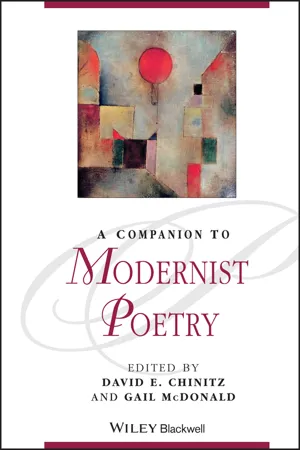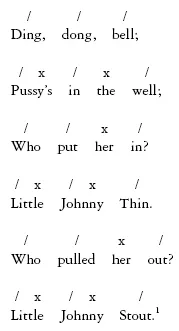![]()
1
Rhythm, Form, and Diction in Modernist Poetry
Michael H. Whitworth
The term “form” was crucial to modernist poets' understanding of their enterprise, but the elusiveness of the concept designated by the word has in crucial respects inhibited critical exploration of modernist poetry; insofar as “form” replaced “genre,” the elusiveness of the concept may, of course, have been part of its appeal. Moreover, its elusiveness is such that attempts at clarification lead away from close analysis of modernist verse rhythm and diction. The metaphors that modernist poets used to articulate ideas of form, though fascinating in their own right, were never intended as tools for the analysis of lines of poetry. The present chapter aims primarily to outline the formal options available to modernist poets, in terms of kinds of prosody and choices in relation to lexis, and only incidentally to place those options in relation to the larger ideas of form.
Breaking the Pentameter, and Other Myths
Modernist writers were self-mythologizing: much in their critical writings emphasizes their discontinuity with the immediate past and serves to obscure connections. The most extreme form of such self-mythologizing comes in the Italian Futurists' call to burn the museums (qtd. in Rainey 5), but even writers like T. S. Eliot, seemingly advancing a more subtle position than that of the Futurists and encouraging engagement with literary tradition (canonically in “Tradition and the Individual Talent” [1919]), nevertheless were selective in terms of what constituted that tradition: the Romantics were largely erased from the canon, and the Victorians seen as little more than late Romantics. Thus, in the field of prosody, a remark such as Ezra Pound's “To break the pentameter, that was the first heave,” which appears parenthetically in Canto LXXXI (Cantos 532), gives the impression that the conventional metrical line of iambic pentameter had run unchallenged from Shakespeare to Wordsworth (and beyond) until modernist poets were brave enough to tackle it; it completely obscures the breadth of metrical theory and practice current in the late nineteenth century (for which, see Hall and Martin).
Similarly, the idea that modernist verse, having broken with the rigid pentameter, was vers libre or “free verse,” and that modernist poems, having broken with the rigid forms of the nineteenth century, were “formless” or “open,” serves to obscure the respects in which modernist poets took heed of the rules that had guided their predecessors, and also the respects in which they evolved rules and conventions of their own. It perpetuates modernist poets' definition of their work in terms of what it is not; removed from their original context, such negative definitions become doubly meaningless. Thus, a recent anthology of poetic forms, although it includes a section of “open forms,” and contests the notion of a “great disjunction” between formalist and nonformalist work, cannot achieve the reassuring specificity that defines verse forms such as the villanelle and the sestina (Strand and Boland 259). “Open,” we might ask, “to what?” Elsewhere, as Eleanor Berry notes, the lack of discrimination in terms like “free” and “open” plays into the hands of critics – largely neoformalists – who would prefer to see modernism as a wrong turn in the history of poetry, a cul-de-sac out of which poetry has reversed (874).
That the validity of the “freedom” of free verse was contested by Eliot and Pound has only served to complicate the picture. In “Reflections on Vers Libre” (1917) Eliot wrote that “the most interesting verse which has yet been written in our language has been done either by taking a very simple form, like the iambic pentameter, and constantly withdrawing from it, or taking no form at all, and constantly approximating to a very simple one.” In the same essay he went on to write that “the ghost of some simple metre should lurk behind the arras in even the freest verse; to advance menacingly as we doze, and withdraw as we rouse”; “freedom,” he explained, “is only freedom when it appears against the background of an artificial limitation” (Selected Prose 33, 34–35). The essay is relatively conservative in that it assumes that the only available forms of “artificial limitation” are traditional. Against Eliot's position, one might argue that, even if some sort of regularity will always emerge in verse, the regularity need not be an established one; it is possible for poets to invent new forms of regularity. Eliot's position grants only a limited validity to new forms of verse, in which they exist to supplement “simple” forms, extending the expressive range of conventional rhythms, but never having an independent existence.
The note of reaction in Eliot's 1917 essay was extended further in the immediately following years in the quatrain poems in Eliot's Ara Vos Prec (1920) and Pound's Hugh Selwyn Mauberley (1920). Pound later recalled that he and Eliot had felt in about 1919 that the “dilutation of vers libre” had “gone too far,” reaching a state of “general floppiness.” The prescribed remedy was the style of verse exemplified by Théophile Gautier's Emaux et Camées (1852) and the “Bay State Hymn Book,” characterized by “Rhyme and regular strophes” (“Harold Monro” 590). That modernist poetry can contain both the irregular rhythms of “The Love Song of J. Alfred Prufrock” and the emphatic rhythms of Hugh Selwyn Mauberley is only a paradox if one associates modernist poetry rigidly with one particular verse form.
Modern Metrical Practices
Despite the impression produced by Pound's phrase about breaking the pentameter, and Eliot's polarization of free verse against “simple” meters, most modernist poets would have been aware of a variety of verse practices, and, more subtly, of a variety of approaches to the analysis of the verse line. Given the prevalence and prestige of an education in classical languages, many would have been aware of classical quantitative meter, and of the possibility – but also the difficulty – of transposing it into English. Eliot, in a 1917 pamphlet on Pound's poetry, notes “a tendency towards quantitative measure” in Pound's more recent poems, and singles out “The Return” as “an important study in verse which is really quantitative” (To Criticize 174). It is to classical metrical analysis that English owes its conventional names for metrical feet. However, in classical analysis the iamb is a foot consisting of a short syllable followed by a long syllable; in analysis of English accentual verse the term has been adapted to indicate a disyllabic foot with the accent on the second syllable (di-dum). The classical trochee (long-short), anapaest (short-short-long), dactyl (long-short-short) have been similarly adapted with the classical long syllable being replaced by the emphasized syllable in English. The two systems are potentially in conflict: the word “bittern” is an iamb in quantitative meter but a trochee in accentual (Carne-Ross 223).
Eliot did not claim that Pound's experiments with quantitative meter were a novelty. Like many modernist poets, he would have known of the brief flourishing of attempts at quantitative meter in the late sixteenth century, in the works of Mary Herbert, Philip Sidney, Edmund Spenser, and others (Attridge, Well-Weighed), and the further experiments in the second half of the nineteenth century, from Arthur Hugh Clough's controversial attempts at hexameter in The Bothie of Toper-na-Fuosich (1848), to Tennyson's and Swinburne's experiments with alcaics and sapphics (Tennyson's “The Daisy” and others, and Swinburne's “Sapphics”). Even if one accepts that modernist poets made a more concerted effort to “break the pentameter” than their predecessors, it must be conceded that they were building on many decades of questioning and experimentation.
While quantitative and accentual accounts of verse both count feet, another approach in English-language verse has been to concentrate on the number of stressed syllables in a line, and to treat the number of unstressed syllables as variable. The late nineteenth-century exemplar of this approach was Gerard Manley Hopkins (1844–89), the posthumous publication of whose poems (in 1918) came too late to influence the first generation of modernists, but provided a later generation with a precedent for experimentation, as did Hopkins's letters (published in 1935 and 1938), and notebooks (1937). Though he created an idiosyncratic terminology and way of marking-up a text, Hopkins's idea of “sprung rhythm” was simple. As he wrote in 1878, “it consists in scanning by accents or stresses alone, without any account of the number of syllables” (107). He illustrated it by analyzing a children's rhyme. (I have followed the simple convention of marking stressed syllables with a forward-slash [/] and unstressed syllables with an “x”; this convention cannot distinguish between the heavily and the lightly stressed, but is sufficient for present purposes.)
Although the number of syllables in each line varies (3, 5, 4, 5, 4, 5), there is a regular number of stresses in each; or rather, it is possible to perform the poem in such a way that it is given a regular number of stresses. The principle is as musical as that of metrical feet –indeed, Hopkins emphasized its musical credentials – but allows considerably more flexibility.
One version of sprung rhythm that acquired particular cultural prestige in late nineteenth-century England was alliterative verse in models which are traceable to the ninth century and which continued into the fourteenth. The dominant model was a line of four stressed syllables in which the first three alliterated, and in which there was a significant break in the half line. It has been summarized in its crudest form as:
bang … bang : bang … crash
But Anglo-Saxon practice allowed greater variation: the key stress was the first stress in the second half of the line; one of the stresses in the first half had to alliterate with it, leaving it optional for t...

